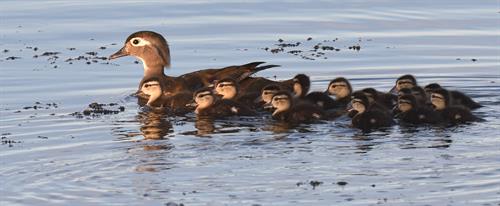This year marks the 50th anniversary of Save Our Streams (SOS) - a pioneering program that has engaged generations of Americans in stream conservation. We have made great progress cleaning up the nation’s waterways since 1969, but we have a long way to go to ensure clean water for every American. Engaging volunteers in the League’s Save Our Streams program will help achieve that goal.
It all started in 1969, when pollution disasters coupled with the growth of mass media changed how Americans viewed the environment - and their responsibility to protect it.
Documenting Disasters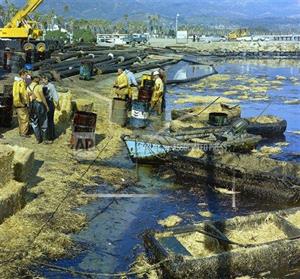
The year started with a bang - or more accurately, a blowout. In January 1969, just a few miles off the coast of southern California, an oil rig punctured a high-pressure pocket of petroleum. Within days, oil washed onto Santa Barbara’s beaches in waves “so thick with crude oil that they broke on shore with an eerie silence,” reported the Los Angeles Times. By the time the months-long rupture was contained, up to 4 million gallons of crude oil had blanketed 35 miles of California coastline and hundreds of square ocean miles.
It was the largest oil spill in U.S. waters at that time, and media coverage was intense from the moment the oil reached the shoreline. The nightly news presented viewers with images of oil-soaked seabirds and seals, dead dolphins, and crews struggling to soak up the spill with hay. Citizens from coast to coast demanded action to prevent future spills. Outdoor America (March 1969) reported that “by the time the leak had been plugged and the cleanup was in high gear on the beaches, some 20 bills on oil pollution were introduced in Congress.”
Later the same year, oil and debris in Ohio’s Cuyahoga River caught fire under a railroad bridge. This was not the first time the river had caught fire, nor was it the largest such fire. It was put out before cameras crews even arrived. However, the fire did catch the attention of national media outlets. Time magazine ran dramatic photos from a 1952 Cuyahoga River fire with the story. Americans were transfixed by the images and the idea that a river could be so polluted that it could actually catch fire - repeatedly.
As the media began to cover more of these stories, people across the country began to wonder about the legacy they were leaving future generations. Citizens became more vocal about what was happening to the environment and their health, drinking water, and local streams. They gathered together to determine what could be done to fix the problems and drove policy responses. Although people (including League members) had been advocating for pollution control for decades, the vivid images of environmental disasters and the personal stories of how Americans were affected created a groundswell of support for national solutions.
In his 1970 State of the Union Address, President Richard Nixon said, “We still think of air as free. But clean air is not free, and neither is clean water. The price tag on pollution control is high. Through our years of past carelessness we incurred a debt to nature, and now that debt is being called.” President Nixon signed an executive order to establish the Environmental Protection Agency. Out of citizens’ calls for action came the Clean Water Act, Clean Air Act, and other environmental legislation - all of which the League had a hand in passing.
One of the best and most enduring examples of the impact everyday people can have on conservation where they live is the League’s Save Our Streams (SOS) program. Born out of the need to clean up pollution-choked waterways, SOS became a model for volunteer stream monitoring programs nationwide.
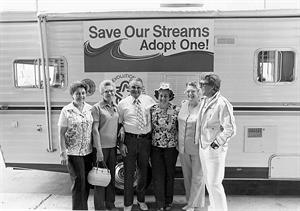
Save Our Streams
Clean water has always been central to the League’s mission. In December 1926, League president Charles Folds announced that “the League has started a national campaign to correct the pollution evil in America.” President Calvin Coolidge commissioned the League to conduct the first national water pollution survey the next year. Since the 1920s, the League has been at the forefront of efforts to safeguard water resources across America, from a national push for sewage treatment in the 1930s to the landmark Clean Water Act of 1972 and today’s efforts to engage more Americans in stream monitoring.
In 1969, League members in Maryland decided to model a stream adoption program after the state’s adopt-a-highway program and called it Save Our Streams. Volunteers checked streams for siltation, fish barriers, and other problems. They reported water pollution, removed trash and debris, and educated the public about preventing pollution. The program’s catchy name and simple approach convinced League leaders that it could be expanded nationally. In 1973, the League developed national program guidelines for local stream adoption, asking every chapter and member to adopt and clean up a local stream. The work being done by the League’s Des Moines Chapter to monitor dissolved oxygen, fecal coliform, and other problems in local streams helped inform the future direction of the SOS program.
In 1975, Save Our Streams Director Dave Whitney started off on an odyssey across the lower 48 states in the Water Wagon - a motor home donated by Coachman Industries - to bring the SOS message to hundreds of thousands of people. The goal was to meet people in their communities to increase awareness of the need for stream conservation. “Sometimes it was just to get people into the water,” recalls Whitney. “[Water is] vital to our lives. You can’t make any more of this stuff.”
Before “citizen science” was even a buzz word, the League recognized that with the right training, volunteers could collect scientifically valid data to assess water quality in local streams. In the mid-1980s, the League and the Ohio Department of Natural Resources created a volunteer monitoring protocol based on the presence and diversity of stream insects and crustaceans (aquatic macroinvertebrates).
For state and local agencies, a major obstacle in using citizen-collected data was the misconception that the data was not scientifically valid. The League developed a plan to ensure that data was valid, and in 1990, it was one of the first such quality assurance plans to be approved by the U.S. Environmental Protection Agency (EPA).
State and local nonprofit groups and government agencies adopted the Save Our Streams model and are still using it today. In 2017, League members launched the Clean Water Challenge with a goal of monitoring water quality at 100,000 more stream sites by the League’s 100th anniversary in 2022. As we celebrate 50 years of SOS, we are leveraging our experience to have an even greater impact on the health of streams and water quality across the country.
Evolving Challenges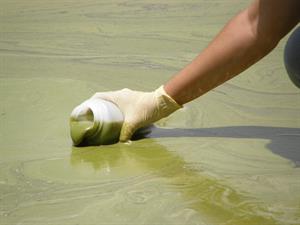
The progress we’ve made - most streams are no longer choked with trash, rivers are undeniably cleaner, water quality has improved - has left Americans feeling more confident in the health of our natural resources.
Yet volunteer stream monitoring is as critical today as it has ever been, because America’s water pollution problems have not been solved - they have evolved.
The greatest threat to water quality today is polluted runoff from farm fields, parking lots, industrial sites, and backyards across America. That runoff - much less visible than an oil spill coating the beach - flows unchecked and untreated into our streams and rivers. It carries animal waste, bacteria, cancer-causing chemicals, and countless other pollutants through our communities.
Yet up to 80 percent of streams across the country and in your backyard are not regularly monitored for pollution - or even monitored at all. If Ikes and other volunteers aren’t out there checking on these streams, the chances are quite high that no one is. Of the streams that are monitored, more than half are not safe for fishing, swimming, or as sources of drinking water.
Water pollution is having real impacts on communities today, whether it’s fertilizer in field and yard runoff; sewage treatment plants that pump nitrogen-, phosphorus-, and salt- laden discharge into our waterways; or fracking wastewater that contaminates local streams. These pollutants are directly linked to health risks in humans, livestock, and wildlife. At the same time, protections for streams and wetlands in our communities are under attack by the very agencies charged with protecting these resources for the American people.
It’s not enough to call for change. We need to take action to defend clean water. That’s what the League was founded to do.
Every single League member can make a difference. Whether it’s talking with neighbors, snapping a photo, coordinating a training, or wading into local waters, there are actions you can take today that will make a difference for clean water.
As Everett Lowry, one of the League’s 54 founders, wrote in 1927 for Outdoor America, every League member must “pick out your favorite river and divide it into convenient assignments” for adoption and protection from pollution.
A Role for Every Ike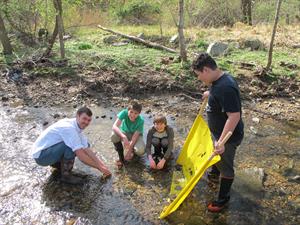
To make a difference today, we need to continue doing what the League has done for almost 100 years - share stories about why these resources matter to us personally, advocate for clean water and build partnerships with like-minded folks, mobilize boots on the ground to monitor water quality, and educate today’s youth about these critical issues.
STORYTELLERS
Many Ikes can captivate an audience with stories of hunting, fishing, birding, and hiking adventures. We need to harness those storytelling skills to connect with our members, partner organizations, and others in the community who value clean water.
Everyone understands the basic importance of clean water. What they don’t know is the important role they need to play in protecting water resources. Your stories can help educate and motivate them to take action, from contacting policymakers or writing a letter to the editor of the local newspaper to educating others about critical issues or making a donation to support stream monitoring.
People learn through stories. (That’s why folk tales were invented.) It’s important to have our facts and scientific findings. But it’s equally important to turn those facts into stories we can share so people know what the League is all about and what we are trying to do to protect their communities. Just as photos and stories of environmental disasters rallied Americans to demand change in 1969, your stories today can show the impact of resource destruction and bad policies.
ADVOCATES
We all know advocates who are so passionate about environmental issues that they are constantly networking, building awareness of problems, and going straight to decision-makers to ask for action. These folks are building partnerships and alliances with like-minded advocates and with people who may not be like-minded . . . yet.
Advocates understand that national and state decisions affect the health of local water resources and they speak up to protect water quality, whether it’s at a local development meeting, a state-level hearing, or on Capitol Hill. They care about clean water and are willing to have the tough conversations necessary to make progress toward science-based solutions.
STREAM TEAMS
Only 20 percent of streams across the country are being monitoring regularly for pollution. Yet 117 million Americans rely on small streams for their drinking water supplies.
The League’s Save Our Streams program trains volunteers to check water quality in local creeks and streams. Even more important, volunteers across the country can now share their findings with the public, policymakers, and each other through our Clean Water Hub. This is a critical step to provide a clear picture of water quality in communities across the country - not just at the end point of major rivers.
If you have attended an SOS training, please follow through by adopting a stream monitoring location and sharing your data on the Clean Water Hub. If you are interested in hosting or attending a training workshop, email sos@iwla.org to be connected with one of our national or regional trainers.
Sound science must drive our conservation policies and clean water protections. Our Stream Teams provide the data that supports our work on Capitol Hill and across America to protect streams and wetlands.
YOUTH EDUCATORS
We need to help youth understand and appreciate the natural world to build a sense of ownership. League programs such as Creek Freaks, Save Our Streams, and chapter initiatives offer hands-on science that shows students how what they’re learning in the classroom applies to real-world problems. For example, if a stream doesn’t have fish in it, the answer may not be to just put more fish in it. By teaching students ways to apply science in the real world - such as checking water quality to find out whether a stream can support fish and other aquatic life - we help students become part of the solution and future advocates.
Unfortunately, in many school districts across the country, science departments are focused solely on coding, robots, and nanotechnology rather than hands-on ecology. Even some of the top universities would rather have their students behind a screen instead of in the field. We are raising the first generation of Americans who spend more time indoors than outdoors. Bringing students into local streams - even for a semester or after school - introduces them to the sounds of nature, the smells of the forest, and the life in the stream. Even better is helping produce future leaders who understand the importance of defending clean water and healthy natural resources.
The Future of Clean Water
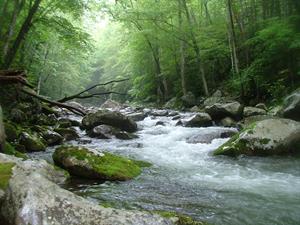
Fundamental protections for clean water are under attack by the very agencies tasked with safeguarding water quality in the United States. In December 2018, the U.S. Environmental Protection Agency (EPA) and Army Corps of Engineers unveiled the Trump Administration’s proposed replacement for the Clean Water Rule - a regulation that tells agency staff how to implement the Clean Water Act. Simply put, this new rule would eliminate protections for vital tributary streams across America.
Under this proposal, it would no longer be illegal under federal law to dump pollution directly into 60 percent of streams nationwide. The rule would eliminate Clean Water Act protections for all streams that flow only after precipitation events - regardless of whether these streams flow to drinking water reservoirs or major rivers. It would also roll back protection for tributaries that flow intermittently - unless they flow directly into another stream that flows continuously all year.
What’s worse, EPA and the Corps specifically request public comments describing how Clean Water Act protections could be scaled back even further. For example, they invite comments on limiting protection to only streams that flow continuously all year. Yet pollution dumped into a stream that does not flow continuously still damages downstream waters.
We want to ensure our streams are protected now and for future generations, but we can’t do it without the support of our members.
Every League member can play a role in protecting clean water — and national staff are here to support you. Which role will you play?
- Storyteller: Every stream - and every person who loves that stream - has a story to tell. We can help you polish your story, connect with local media outlets, and share your story with others who care about clean water. Email info@iwla.org and let us know what you need.
- Advocate: We’re in the clean water fight of our time. We need advocates who are willing to talk about the issues at community events and with their state legislators. We also need people who will speak up to members of Congress and federal agencies and can spread the word about the need for others to act. The very agencies that are supposed to protect your water are trying to undermine those protections. Speak out! Your voice matters. Visit iwla.org/cwa for more information about this fight.
- Stream Team: Hundreds of League members were trained as stream monitors in 2018. Now is the time to pick a monitoring site, organize a team on the Clean Water Hub, and share your results with the public. Not sure about the best place to monitor? Need help getting started on the Hub? Email sos@iwla.org and League staff will help get you started.
- Youth Educator: The League developed Creek Freaks to translate stream ecology and the Save Our Streams program into hands-on activities for youth. You can access activities, lesson plans, and more on our website at iwla.org/creekfreaks. Want to schedule a training to become a Creek Freaks leader? Visit iwla.org/training to make your request.
After 50 years of Save Our Streams, we’re celebrating an incredible legacy of pioneering work on volunteer stream monitoring. League members have much to be proud of. Yet we still have work left to do.
We’ve seen the difference everyday citizens can make by protecting the streams where they live. With our Clean Water Challenge, we’ve set the course for the future of stream monitoring.
This is our signature issue. This is a seminal moment in the history of clean water. We need every Ike to get involved.
